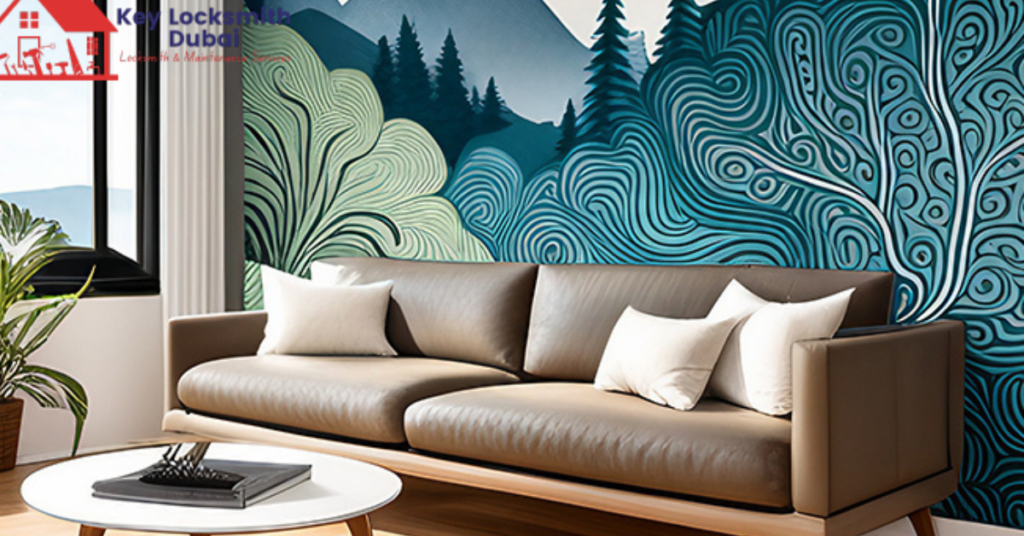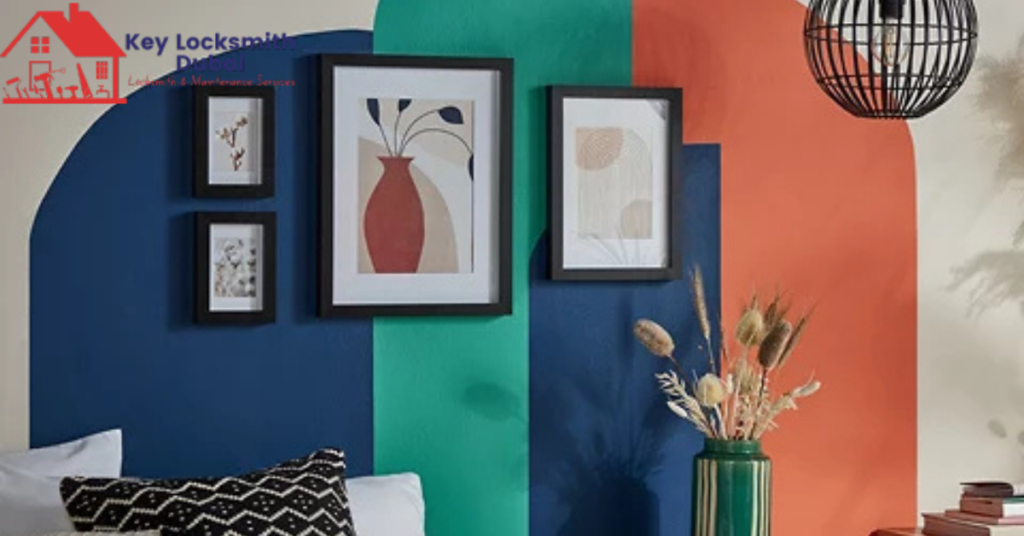Transforming your living space into a reflection of your personality is as easy as adding a lick of paint, but why stop there? Plaid does more than just change the color of your walls, infusing them with stripes, dots, and a variety of other designs that can really bring your home to life. In this guide, we’ll explore different painting techniques for your home and office, and discuss the return of these designs to modern decor.
From artistic expression through lines that can elongate a room, to playful dots that can add a whimsical touch, the patterns you choose can greatly transform and personalize your space. We’ll give you a step-by-step guide on how to apply these designs, review the many benefits they offer, from adding visual interest to cleverly hiding wall imperfections, and discuss how to share tips to ensure your pattern painting project is a success. Success is a great achievement.

When you realize it’s time to update your walls with a new style of paint, the key locksmith team is ready to work on your project. With years of experience and a passion for excellence, key locksmith doesn’t just cover your walls. They transform your space into a reflection of your individual style. Join us as we explore how painting your walls with patterns can transform your living space, with key locksmith, a skilled painter with a creative flair. Combining technology with stunning effect.
Contact us at keylocksmith today and see how our team of painters can make your wall painting idea a reality.
Revival of Engraved Paintings for Your Home or Office
The magic of patterned paintings is making a huge comeback in contemporary interior design, transforming ordinary spaces into extraordinary displays of creativity. This graffiti renaissance isn’t just about aesthetics. It’s a movement that reflects a shift toward personal spaces that tell a story. Homeowners and office managers alike are embracing lines, dots, and more intricate designs, recognizing their ability to inject vibrancy and personality into any space.
These patterns do more than decorate a wall. They create focal points, influence mood, and transform the perception of a space. This revival also points to the rich fabric of historic design, where patterned walls were a symbol of sophistication and elegance. Today’s trendsetters are reinventing these classic concepts with a modern twist, using advances in wall painting technology and application techniques to achieve looks that were previously only possible for the most skilled craftsmen.

How to Make a Carved Art Board: A Step-by-Step Guide
Working on a carved painting project can be exciting, but achieving that crisp, professional look takes more than just enthusiasm. It requires solid planning and a process that starts with proper preparation.
This step-by-step guide is designed to guide you on your journey from bare walls to chiseled perfection. It starts with the essential preparation of your space, then moves on to the main design of your chosen design, and ends with specific drawing techniques to embody your vision.
Room and Wall Preparation
The foundation of a successful stereotype project is thorough preparation. Start by clearing the room of furniture or moving objects to the center and covering them with a drop cloth to protect them from paint stains. Make sure your walls are clean, smooth, and free of stains. Any holes or bumps will be magnified after you apply the paint.
Then apply a coat of primer to ensure your colors are vibrant and last longer. Tapering edges, ceilings, and adjacent walls with painter’s tape will prevent unwanted streaks and create sharp, clean lines for your pattern.
Draw your pattern.
When it comes to laying out your pattern, precision is key. Use a tape measure and level to mark out your design, making sure the lines are parallel or the dots are evenly spaced. This may require a grid or reference points to guide your positioning.
For more complex patterns, consider using a template or putting a picture on the wall for a sketch. Patience during this step pays off in the form of flawless execution, preventing the kinds of imperfections and disproportions that can detract from the final look.
Drawing Techniques for Each Type of Pattern
Each type of pattern requires a unique approach using a brush or roller. For lines, it’s important to keep the lines straight, so a steady hand and a small artist’s brush can define the edges before filling them in with a larger roller. Dots may require a circular motion to achieve a perfect round shape, or you can use a ready-made template to achieve a uniform look. Using geometric shapes, artists can create sharp edges, and layering colors may be necessary to achieve the desired effect.
Understanding the specific techniques and tools required for your wall painting idea is essential to creating a professional and satisfying result.
Benefits of Painting
Incorporating pattern into your wall decor isn’t just a bold style choice – it’s a strategic decision that offers many benefits. A patterned wall mural can transform a room from a basic area into an attractive and unique space. It’s not just about visual appeal; These designs can also enhance the functionality and feel of a room.
Let’s explore the benefits that textured walls can bring to your space, from aesthetic improvements to practical solutions to common wall problems.
Adds visual interest.
Pattern has a natural ability to draw the eye and become the focal point of a room. Whether it’s through the subtle inclusion of diagonal lines or the bold statement of a large geometric print, the raised graphic adds layers of texture and depth. This visual interest can transform a wall into a work of art, making a room more inviting and inviting.
Increases the space and volume of a room.
Clever use of pattern can change the perception of a room’s dimensions. For example, vertical stripes can make ceilings appear higher, while horizontal patterns or diagonal stripes can make a room appear wider. Light and dark colors can work together to create a sense of depth, making a space appear larger or cozier, depending on the desired effect.
Personalize your living space.
Engraved painting offers the opportunity to personalize your space to reflect your personality and taste. With an endless variety of designs, from classic lines to modern abstracts, you can create a space that is clearly yours. It’s an opportunity to infuse your walls with your favorite colors, shapes, and patterns, resulting in a home environment that reflects your personality.
Covers wall imperfections.
Patterns are not only decorative, they can also be used intentionally to hide imperfections in your walls. Textured paints and specific pattern designs can hide uneven surfaces, cracks, and other imperfections, making them less noticeable and giving your walls a fresh, modern look.
Engraving Engineering
The geometry of patterned drawings is the pursuit of shapes and lines that can define the mood and character of a room. Here, mathematical precision meets the fluidity of art, resulting in designs that can be both surprising and harmonious.
Man drawing a dark brown line inside painter’s tape.
Stripes on your walls.
Stripes are a timeless choice that can adapt to any decorating style. They can be bold or subtle, wide or narrow, vertical or horizontal. The direction and width of the stripes can stretch across the dimensions of the room, making spaces appear more spacious or cozy. The color contrasts can be as subtle or as large as you like, making stripes a versatile option for adding sophistication and visual texture to your walls.
Add polka dots.
Polka dots are a wall painting idea that brings a sense of fun and energy to a room. They can range from small, subtle dots that give a nice, textured look, to large, bold circles that make a statement. Using dotted lines, you can introduce multiple colors, change the size, or play with the spacing to create a unique pattern flow. They’re perfect for spaces that need a bit of fun or retro flair.
Meanders, mountain patterns, and the iconic arch.
For those looking for a more dynamic and modern feel, herringbone and mountain patterns can give a room movement and a contemporary edge. Zigzag lines provide a sharp, rhythmic pattern that can energize a space, while mountain patterns bring a sense of calm and nature.
Additionally, the popular arch style, with its rounded edges and classic shape, can add a touch of elegance and historical resonance, serving as a stand-alone feature or a recurring design element.
Tips for a Successful Pattern Drawing Project
Approaching a carved painting project with a well-thought-out plan and a few insider tips can make the difference between a DIY disaster and a stylistic triumph. It’s the small details and preparation steps that pave the way for a smooth painting experience and stunning results.
Below, we take a look at practical tips that can help you avoid common mistakes and ensure the success of your engraving project.
Test a small area first.
Before applying the pattern to the entire wall, it is wise to do an initial test on a small, inconspicuous area. This test allows you to see how the color and pattern perform under the specific lighting conditions in your room and can help you make any necessary adjustments before applying it on a full scale. Testing a small area first is also a great opportunity to practice your technique and ensure that the pattern looks as expected on a large scale.
Keep the paint consistent
Consistency in your paint will ensure that the finished look is uniform and professional. This means using the same brand and batch of paint throughout the project to avoid multiple colors or color inconsistencies. It is also important to mix the paint thoroughly for a consistent adhesion and finish, which is especially important when working with patterns that require sharp lines and clean edges.
Take your time.
Patience is a virtue, especially in the world of carving. Rushing the process can lead to mistakes that are difficult to correct once the paint has dried. Take the time to measure, apply, and position the pattern accurately. When painting, work methodically to maintain the integrity of the design, and allow each layer to dry thoroughly before applying the next. Remember that the quality of the results is directly related to the time and care you put into the process.
Frequently Asked Questions About Engraving
Can I combine different styles?
Yes, you can combine different styles to create a more intricate and personalized look. The key is to maintain a consistent color scheme or theme to ensure that the patterns complement each other rather than clash.
It’s also a good idea to balance more complex designs with simpler ones to avoid cluttering the space. For example, pairing a bold geometric pattern with delicate lines can create a subtle contrast.
How do I maintain painted, patterned walls?
Maintaining patterned painted walls is similar to maintaining regular painted walls. Regular dusting and gentle cleaning with a damp cloth can keep the finish clean. For heavy-traffic walls that are likely to show marks or scratches, such as a child’s bedroom, use washable paint, which makes it easier to clean.
Additionally, repainting every few years can keep the colors vibrant and the patterns distinct.
Can I use stencils for this type of project?
Stencils are a great tool for patterned painting projects, especially for those looking for precision and uniformity in their wall painting ideas. They are especially useful for creating repeating shapes, such as polka dots or floral patterns. Stencils can be purchased or custom-made and provide a template that ensures consistency across an entire wall or room.




